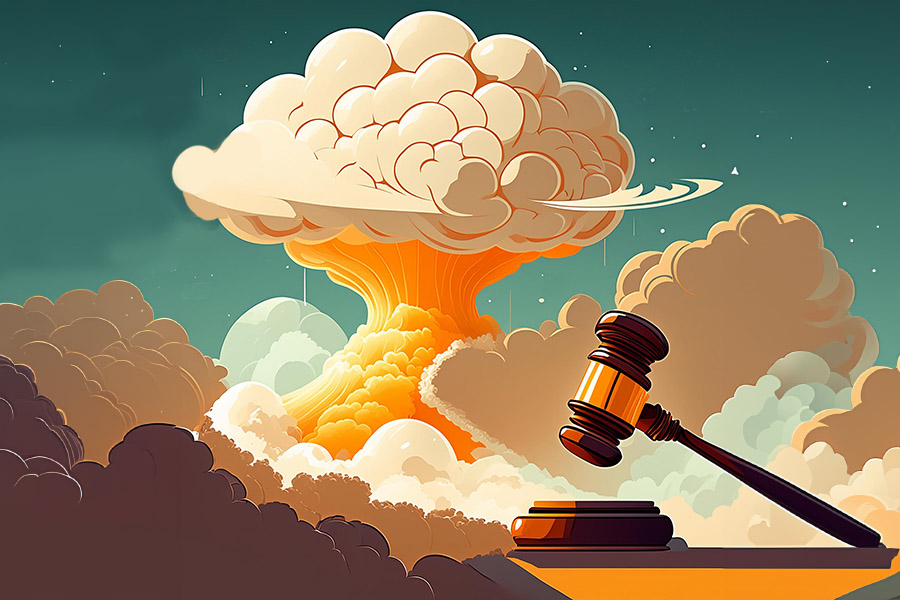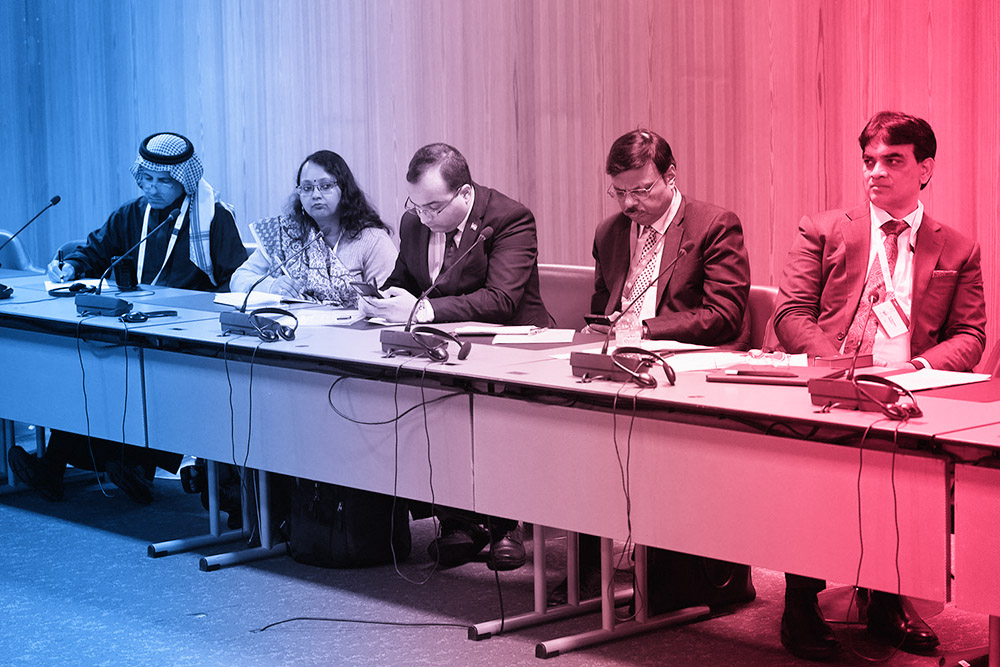Astana Club, Global Alliance of Leaders| Nur Sultan, Kazakhstan | November 15-17, 2021
By Jonathan Granoff, President, Global Security Institute
History never stands still. The movement of nations can be guided by their agreements which become law through treaties or the excessive pursuit of perceived limited self-interest guided by the quest for superior power. One path can lead to peace. The other to pieces.
The United Kingdom, United States, Russia, China, and France have pledged under Article VI of the Nuclear Non-proliferation Treaty (NPT) to “pursue negotiations in good faith on effective measures relating to cessation of the nuclear arms race at an early date and to nuclear disarmament.” The International Court of Justice has unanimously ruled that “there exists an obligation to pursue in good faith and bring to a conclusion, negotiations leading to nuclear disarmament in all its aspects under strict and effective international control.” The ICJ opinion applies to all nations, especially those with nuclear weapons, which thus includes the five permanent members of the UN Security Council, as well as North Korea, India, Pakistan and Israel. Yet, all of them are either modernizing or expanding their arsenals or doing both.
In addition, in review conferences of the NPT numerous threat reducing measures that enhance the rule of law while reducing no nations security have been pledged as a means of fulfilling the Article VI obligations. These include, inter alia, the following:
An unequivocal undertaking by the nuclear-weapon States to accomplish the total elimination of their nuclear arsenals leading to nuclear disarmament to which all States parties are committed under Article VI.
Increased transparency by the nuclear-weapon States with regard to the nuclear weapons capabilities and the implementation of agreements pursuant to Article VI and as a voluntary confidence-building measure to support further progress on nuclear disarmament;
Concrete agreed measures to further reduce the operational status of nuclear weapons systems;
A diminishing role for nuclear weapons in security policies to minimize the risk that these weapons ever be used and to facilitate the process of their total elimination; and,
The engagement as soon as appropriate of all the nuclear-weapon States in the process leading to the total elimination of their nuclear weapons.
Further, it is worth noting that every nation except India, Pakistan, Israel and North Korea, have, in these review conferences, pledged to pursue “policies that are fully compatible with the treaty and the objective of achieving a world without nuclear weapons”; recognized the importance of constraining “the development and qualitative improvement of nuclear weapons and ending the development of new types of nuclear weapons”; and “noted … consideration of negotiations on a nuclear weapons convention.”
What has changed such that these nations appear to have stepped back from fulfilling their legal obligations? Could it be a shared recognition that greater levels of political cooperation are needed to adequately address critical threats to modern civilization posed by climate change, pollution of the oceans, pandemics, and tears in the fabric of the web of life described as bio-diversity where species are being destroyed at thousands of times the evolutionary base rate?
It appears we have become more aware that without change human development is being pursued in derogation of the regenerative capacity of nature to sustain human life. This description of what we are increasingly coming to understand ignores new technologies such as artificial intelligence, directed energy weapons, space weaponization, data mining, and quantum computing which will have increasingly fast impacts on society and the natural world. What has also changed is that our global economy and information systems have become intensely integrated. Has this generated a call for enhancing Human Security or appropriate allocations of resources to fulfill the Sustainable Development Goals?
Hardly. Here is what appears glaringly before us.
The United States is committed to a “modernization” program of vast sums of money without even ratifying the Comprehensive Test Ban Treaty which could constrain some new developments and be consistent with NPT pledges. While arguing to be trusted by the international community with maintaining global security, it, especially along with Russia, argues that it is committed to “strategic stability.” But, in no way can this square with their respective pursuits of military advantage. For example, new components in nuclear weapons designs will give the U.S. arsenal enhanced capacity to detonate with greater specificity. Amplified “hard-target kill capacity” is planned for over 1,300 warheads. Although the Air Force describes the components as routine engineering improvements to warheads speeding at over 15,000 miles per hour, experts predict these new fuses as giving greater specificity to timing and place of explosion that will more than double the counterforce capabilities of the U.S. submarine fleet. This example is cited to highlight the pursuit of military advantage.
Russia appears to be developing and brandishing proudly new improved destructive capacities, all the while joining the U.S. in criticizing the Treaty to Prohibit Nuclear Weapons as harming strategic stability. These include not merely the new Sarmat intercontinental ballistic missile (ICBM), but also new hypersonic delivery vehicles, a nuclear powered underwater drone, an air launched ballistic missile, and the Burevestnik, touted as a nuclear-powered cruise missile capable of having an unlimited range and capacity to evade any defenses.
This new arms race does not even discuss new developments in non-strategic weapons arsenals with increasing accuracy and speed, which Russia has a “lead” in deploying. Are these weapons for new battlefield use? Are they more likely to break the taboo against using nuclear weapons? Are they being designed to be more usable and compliant with limitations of International Humanitarian Law?
As for China, it presently has an arsenal of less than 400 nuclear missiles that currently is dwarfed by Russia and the U.S. which possess over 95% of the world’s approximately 13,000 nuclear weapons. However, it appears to be vastly expanding its arsenal with the goal, as Xi Jinping has described, to become the “Strong Military Dream” in which Beijing will have the most advanced military capabilities by 2049.
China is building new heavy ICBMs, hypersonic delivery vehicles, a new ballistic missile submarine, an air-launched ballistic missile, and a whole quiver full of missiles that can interchangeably carry either
nuclear or conventional warheads. Simply put, China is moving forward and expanding both its numbers and its qualitative capabilities at a rapid clip. It is likely that it will acquire at least 1,270 nuclear warheads by 2030 – closing in on or exceeding the roughly 1,300 strategic warheads the United States currently has deployed on its intercontinental ballistic missiles.
In 2020, the editor-in-chief of Global Times which does not vary from China policy wrote that “China needs to expand the number of its nuclear warheads to 1,000 in a relatively short time. It needs to have at least 100 Dongfeng-41 strategic missiles.” He emphasized that “[t]he number of China’s nuclear warheads must reach the quantity that makes U.S. elites shiver.” Rather unabashedly, it would appear, China is now engaged in a huge and fast nuclear weapons build-up. It has learned some kind of lesson from the conduct of Russia and the U.S.
No mention is made here about the complex and dangerous brinkmanship regarding Taiwan, increasing challenges on the Korean peninsula, cybersecurity, nor the degradation of international order arising from the invasion of Iraq, virtual annexation of Crimea, ignorant posturing of former President Trump, the current deterioration of Russia NATO relations, and the bellicose rhetoric that has become nearly normalized. Nor is there an analysis of the potential to lower operational status by No First Use policies or the increasingly clear benefits of nuclear weapons free zones or accomplishments such as START renewal.
What these reflections seek to emphasize is that the direction of the current bus is wrong. It disregards a critically important pillar of international affairs which offers a grave future. Pacta Sunt Servanda, promises solemnly entered into amongst nations must be honored. Failure to do so will make bullets verbs and in the nuclear age that means the annihilation of civilization.
At the height of the Cold War leaders of six nations – Argentina, India, Mexico, Tanzania, Sweden and Greece – helped move Moscow and Washington to truly engage in dialogue which led to enormous progress in global security. Such a push is required now. The need for leadership to change from excessive military nationalism and reliance on extreme threats to pursue stability must be changed to a shared recognition of common interests and the pursuit of realistic Human Security.
Jonathan Granoff is the President of the Global Security Institute, a representative to United Nations of the World Summits of Nobel Peace Laureates, a former Adjunct Professor of International Law at Widener University School of Law, and Senior Advisor to the Committee on National Security American Bar Association International Law Section.








